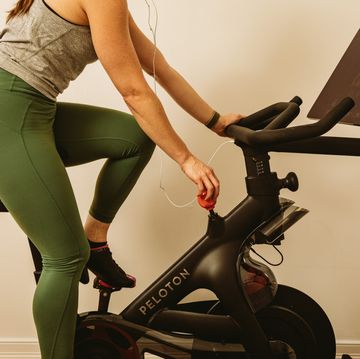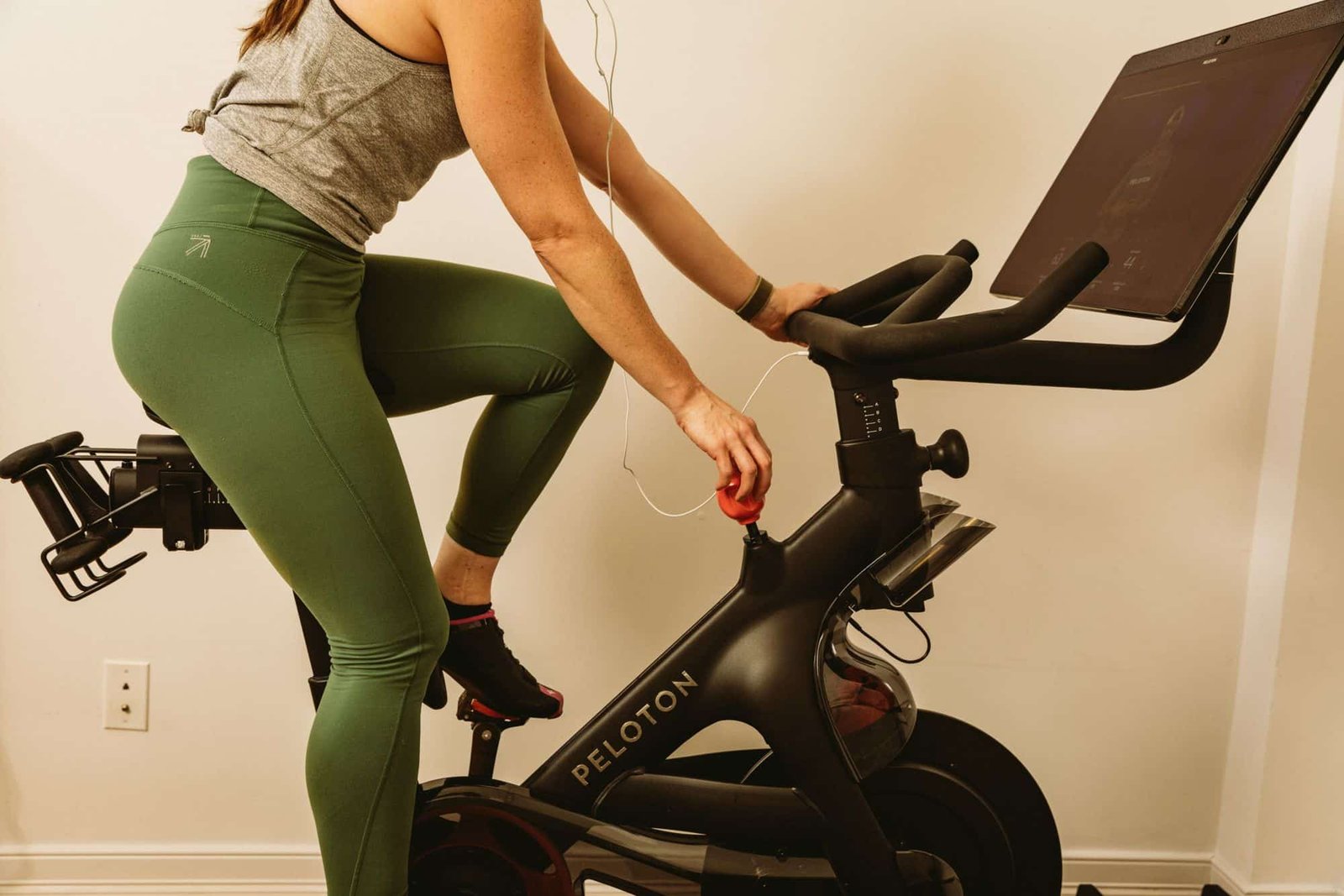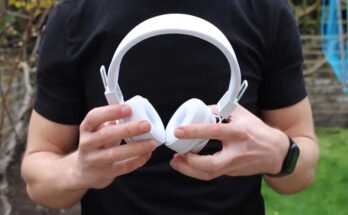To calibrate a Peloton Bike or Bike+, access the settings menu, then follow the on-screen calibration instructions. Ensuring calibration accuracy enhances workout effectiveness and equipment longevity.
Calibrating your Peloton Bike or Bike Plus is a crucial step for optimal performance and precise workout metrics. It ensures that the resistance levels displayed on your screen match the actual difficulty you experience while pedaling. Riders seeking to achieve accurate personal records and fair competition in leaderboard rankings must keep their bikes finely tuned.
Regular calibration maintains the integrity of your fitness journey by providing consistent feedback on your efforts. This simple process can be the difference between reaching your fitness goals and falling short, making it an essential routine for every Peloton enthusiast. Users should note, calibration might not often be necessary, but it’s a good step when metrics seem off or after moving the bike.
:max_bytes(150000):strip_icc()/Tout-The-Peloton-Bike-Really-Is-Every-Riders-Dream-Come-True-2000-13b0204aa6ea4233a96e11cc3b8eeadd.jpg)
Credit: www.shape.com
Calibration Basics For Peloton Enthusiasts
Calibration Basics for Peloton Enthusiasts ensures a top-notch ride each time. Calibration sets your bike’s resistance levels. A well-calibrated Peloton can transform a good workout into a great one. Get these basics right for a smoother, more effective ride.
What Is Calibration?
To understand calibration, think of it like tuning an instrument. It’s the process of setting your Peloton bike’s resistance to its proper level. Correct calibration means accurate performance tracking.
Importance For Your Ride Experience
- Ensures fair play in group rides and challenges.
- Offers true workout metrics for tracking progress.
- Makes sure effort matches output numbers.
Initial Setup: Unboxing To First Ride
Welcome to the exciting journey from the unboxing of your new Peloton Bike or Bike Plus to your very first ride. These steps ensure a seamless setup and a fantastic start to your fitness adventure. With attention to detail and a bit of care, you’ll be pedaling towards your goals in no time.
Assembly Essentials
Before diving into the assembly of your Peloton Bike, gather all necessary tools. Here’s what you’ll need:
- Adjustable wrench
- Screwdriver set
- Level for ensuring stability
Each package comes with a manual and assembly instructions. Follow them step by step. Consult online tutorials if needed. Proper assembly guarantees safety and optimal performance.
Initial Inspection Points
Perform a thorough inspection once your Peloton Bike is assembled. Check these critical areas:
| Component | Inspection Criteria |
|---|---|
| Frame | Look for scratches or dents. |
| Screws and Bolts | Ensure they are tight and secure. |
| Screen | Check for damage; make sure it powers on. |
| Pedals | Verify they spin freely and are tightly attached. |
Once all points are checked and your Peloton Bike passes the inspection, proceed to the final steps. Adjust the seat, handlebars, and clip in your shoes. Now, take a deep breath. Your first ride awaits!
Step-by-step Calibration For Peloton Bike
Making sure your Peloton bike is properly calibrated is key for an accurate workout. Follow these straightforward steps to ensure your bike is ready for peak performance.
Gathering Necessary Tools
Before you start, get these items:
- Calibration tool (provided with your bike)
- Touchscreen Allen wrench (also included)
- Clean, dry cloth
Adjusting The Bike’s Settings
First, reset your bike’s settings.
- Turn off your bike.
- Hold down the resistance knob for 5 seconds.
- Turn the bike back on.
Fine-tuning The Resistance Knob
Next, fine-tune your resistance.
- Set bike resistance to ‘0’.
- Hold calibration tool flat against the screen.
- Rotate the resistance knob until the tool is level.
Finish by tightening the knob and wiping the bike down with your cloth.

Credit: www.onepeloton.com
Calibrating Peloton Bike Plus: What’s Different
Calibrating Peloton Bike Plus: What’s Different involves fine-tuning sensor settings for accurate performance feedback. Compared to the original, Bike Plus offers an enhanced calibration process. This essential setup ensures cyclists get the most out of their workouts by providing precise metrics. Understanding the new features and steps helps users maximize the effectiveness of their Bike Plus. Let’s explore these distinctive elements.
Auto-calibration Feature
Peloton Bike Plus stands out with its Auto-Calibration Feature. Unique to this model, it streamlines your setup. No manual checks are needed as the system adjusts resistance levels automatically. This innovation ensures users experience accurate ride metrics every time.
Manual Calibration: When And How
Even with auto-calibration, certain situations call for manual calibration. These include:
- After assembly: Confirm accuracy from the start.
- Post-movement: If you relocate the bike, recalibrate.
- Changes in resistance feel: If rides feel different, recalibrate.
- Routine maintenance: Check for consistent performance.
To manually calibrate, follow these steps:
- Access your settings on the touchscreen.
- Find ‘Calibration’ and tap on it.
- Follow on-screen instructions.
Manual calibration on the Bike Plus may seem daunting, but it’s a simple process. Peloton guides you through every step to ensure a smooth and accurate setup. This gives peace of mind for the most reliable and enjoyable cycling experience on your Peloton Bike Plus.
Expert Tips To Ensure Accurate Calibration
Getting the most from your Peloton bike or Bike Plus starts with proper calibration. This ensures every ride accurately reflects your effort. Careful calibration aligns your fitness goals with real results. Now let’s dive into how to avoid common mistakes and maintain accuracy over time.
Common Calibration Mistakes
To achieve peak performance, be aware of these pitfalls:
- Rushing the process: Take your time for precise adjustments.
- Ignoring instructions: Follow Peloton’s guidelines closely.
- Using incorrect tools: Always use tools recommended by Peloton.
- Skipping steps: Each step is crucial for total accuracy.
By paying attention to these errors, your bike stays perfectly tuned.
Maintenance For Continued Accuracy
Maintain your bike’s accuracy with regular checks:
- Monthly inspections: Examine for wear and tear.
- Clean regularly: Keep components dust-free.
- Tighten bolts: Secure all parts firmly.
- Re-calibrate: Adjust as needed over time.
The right upkeep promises a consistent, high-quality riding experience.

Credit: www.bicycling.com
Troubleshooting Calibration Issues
Got a Peloton bike at home? Keeping it well-calibrated ensures a smooth ride and accurate stats. But what happens when things go off-track? Let’s dive into troubleshooting calibration issues.
Identifying Symptoms Of Miscalibration
Know the signs to catch problems early. Here’s what to look out for:
- Inconsistent resistance levels – when it feels either too easy or too hard.
- Off-target metrics – when your output numbers don’t match your effort.
- Strange bike noises – unusual sounds can signal a need for adjustment.
Solutions For Persistent Problems
Facing stubborn calibration issues? Here’s a methodical approach to fix them:
- Reset Calibration: Start fresh by resetting your bike’s calibration settings.
- Check Components: Ensure all parts are secure and undamaged.
- Contact Support: If problems persist, Peloton’s support can guide you.
| Problem | Quick Solutions |
|---|---|
| Resistance doesn’t change |
|
| Incorrect output reading |
|
Maximizing Your Peloton Experience Post-calibration
Getting the most from your Peloton rides starts with proper calibration. Once your Peloton Bike or Bike Plus is calibrated, you unlock a smoother, more accurate ride. New challenges and enhanced performance await, so let’s ensure you fully benefit from your finely tuned setup.
Optimizing Workout Sessions
Post-calibration, your Peloton Bike readings are more precise. This means each pedal stroke counts just as it should. Tracking progress becomes easier and more rewarding. Here are ways to optimize your workout sessions:
- Set Clear Goals: Target specific heart rate zones or output levels.
- Monitor Metrics: Keep an eye on improved accuracy in distance and resistance.
- Vary Your Routines: Try new classes with confidence in bike readings.
Remember, consistent performance feedback leads to targeted improvements.
Integrating With Peloton’s Community
Calibration can enhance your community involvement. Peloton’s Leaderboard thrives on competitive spirit and shared encouragement. Here’s how to integrate further:
- Join Live Classes: Compete with others in real-time with an equally calibrated bike.
- Participate in Challenges: Your new bike setup helps you push up those ranks.
- Share Achievements: Celebrate milestones with accurate data to back your triumph.
Enjoy a leveled playing field while forging stronger connections with fellow riders.
Frequently Asked Questions For How To Calibrate Peloton Bike And Bike Plus
How Do You Recalibrate A Peloton Bike Plus?
To recalibrate a Peloton Bike Plus, access the settings menu, select “Device Settings,” choose “Home Installation,” and follow the on-screen recalibration instructions. Ensure your bike is on a level surface before starting.
Does Peloton Bike Plus Automatically Adjust Resistance?
Yes, the Peloton Bike+ features Auto-Follow, which automatically adjusts resistance during classes based on instructors’ cues.
How To Tell The Difference Between Peloton Bike And Bike Plus?
The Peloton Bike+ offers a larger, rotating touchscreen, enhanced speakers, and Auto-Follow resistance. It also supports Apple GymKit, differing from the original Peloton Bike.
How Long Does It Take To Calibrate Peloton Bike?
Calibrating a Peloton bike typically takes about five minutes once you’ve started the process. Follow the on-screen instructions for swift completion.
Conclusion
Calibrating your Peloton bike ensures an optimized workout experience every time you ride. By following the steps outlined, both Peloton Bike and Bike Plus users can fine-tune their machines for precise performance. Remember, regular maintenance goes hand-in-hand with calibration to maintain the best ride quality.
Embrace these simple tweaks for a smoother, more efficient cycling journey. Keep pedaling towards your fitness goals with confidence!



